Lenovo ThinkStation P320 Tiny Performance and Power Consumption
Instead of going through the entire Linux-Bench test suite, we are going to show a few performance and power numbers here to give a general sense of performance. We actually planned to do storage testing, but then we realized that there was a huge variability in terms of what drives could be found in machines.
Python Linux 4.4.2 Kernel Compile Benchmark
This is one of the most requested benchmarks for STH over the past few years. The task was simple, we have a standard configuration file, the Linux 4.4.2 kernel from kernel.org, and make the standard auto-generated configuration utilizing every thread in the system. We are expressing results in terms of compiles per hour to make the results easier to read:
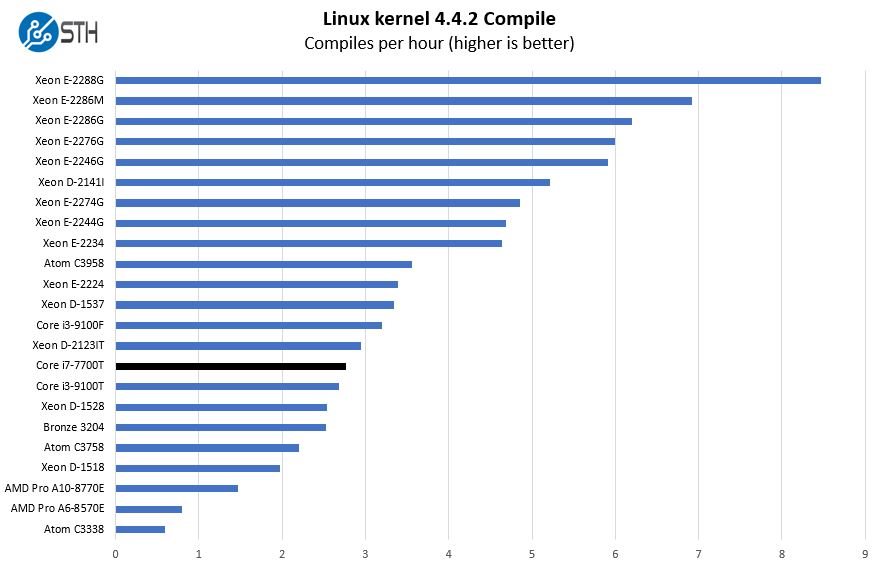
Here we get performance between that of an Intel Xeon D-1528 6 core/ 12 thread part and a Xeon D-2123IT 4 core/ 8 thread part. We also get performance between the Project TinyMiniMicro Dell OptiPlex 3070 Micro and its Core i3-9100T and the higher-TDP Intel Core i3-9100F. Of course, one gets the integrated GPU with the Core i7-7700T.
7-zip Compression Performance
7-zip is a widely used compression/ decompression program that works cross-platform. We started using the program during our early days with Windows testing. It is now part of Linux-Bench.
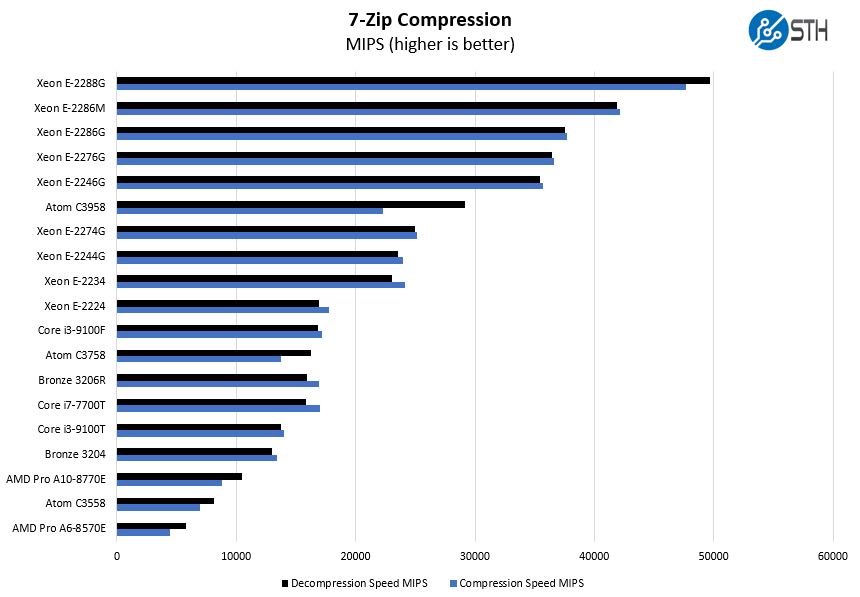
The reason we are seeing the Core i7-7700T competing with the Core i3’s of two generations later is also partly due to AMD entering the market. Intel went from extremely incremental improvements to major jumps. For example, the Core i5-7500T was a 4-core part while the Core i5-8500T is a six-core part. As a result, we get some benefit from Hyper-Threading, but we do not get a huge delta. When looking across generations, there are huge inflection points in performance when we get to 8th and 9th generation Intel Core processors because of increased competition from AMD. Let us face it, the AMD A6 and A10 we found in the Project TinyMiniMicro HP EliteDesk 705 G3 Mini CE Review were not fast, but we have Ryzen units where the performance story changes quite a bit.
OpenSSL Performance
OpenSSL is widely used to secure communications between servers. This is an important protocol in many server stacks. We first look at our sign tests:
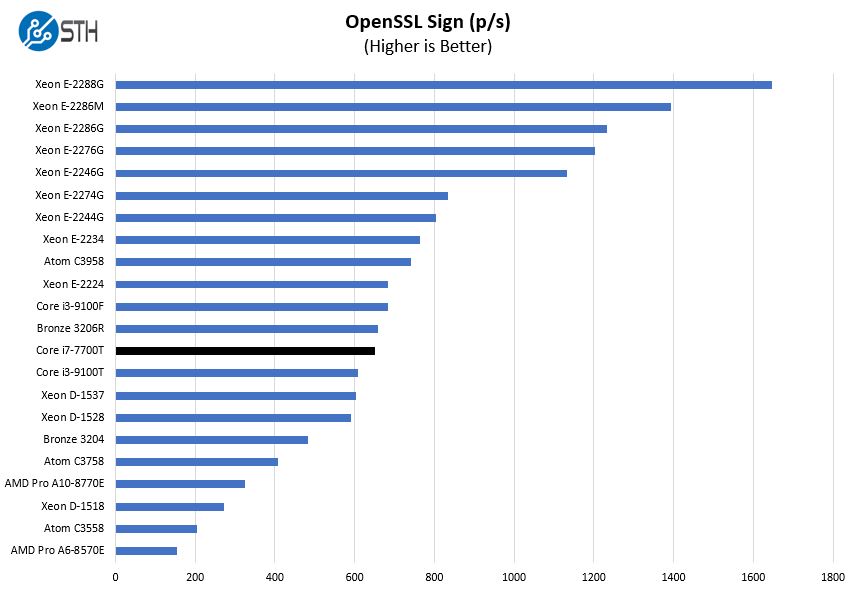
Here are the verify results:
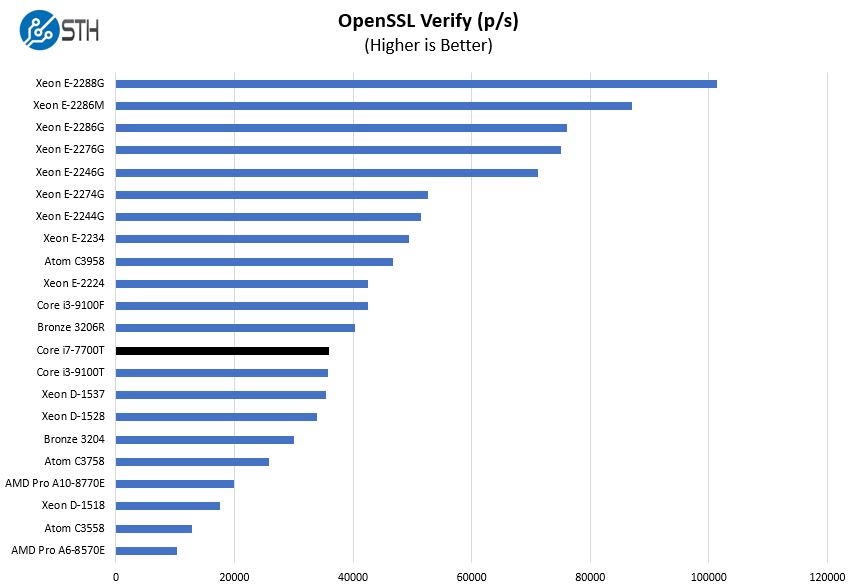
Here we see something very interesting. The Intel Core i7-7700T is running only slightly ahead of the Core i3-9100T in the OpenSSL sign test. This is because the system is being thermally limited. At some point power and thermal constraints limit performance and Turbo plus Hyper-Threading do not overcome this delta. Part of our investigation for Project TinyMiniMicro is to do some spot checking of different vendor cooling solutions so we ordered similar configurations for some segments to see if there are thermally-driven performance deltas in this segment. That is for the future, and these systems are unique in that they also have the NVIDIA Quadro GPU.
Next, we are going to look at power consumption before moving onto our key lesson learned and final words.

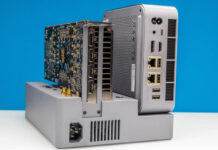


Given the thermal throttling, it would be nice to include stress related heat measurements from the onchip sensors as well a direct measurement of the temperature of the air from the exhaust fans.
One thing I’m hoping for is a discussion of how to mount all these machines in a standard 19″ rack and replace all the separate power bricks with a single rack-level DC power supply. In my opinion, stuffing a bunch of power bricks into a confined space could reduce ambient cooling and turn them into fire bricks. If these mini PCs are going to be used as small servers, how to rack mount and power them may be an important consideration.
I managed to build 3x P320 proxmox ceph nodes in production env with 2 nvme osd and 64 Gb RAM, NViDIA P600 per node.
Proxmox OS sits on ssd thru tiny mb sata ports.
ram i think was single ch. mode by design.
Not necessary a fan of putting a display card there because throttling, and that if I have the price to go on full spec I might as well have the budget to poke with other SFFs that are also small and offers way better thermals. But since that’s the only 1L systems offering pcie slot (no pcie whitelists afaik), throw in a 10G card or something and use that as a core router might be a good way to go for homelabs… given one is willing to not put a shield there since its non standard
Lenovo do offer 4port i350 with shields though, though I’m not sure about pricing and availability in the NA.
I have toyed around with the idea of using USFF or SFF nodes.
But everytime i come to the conclusion, that for the same or even less money (in this very case of the reviewed unit), i can buy a uATX/ATX system that is much faster, much much more future proof, and not missing important parts.
Using a 7th Gen Core i7 when i get same cores/thread with 8th gen i3? With a upgrade option to 8/16 C/T?
Expanding networking (with Dual 1 Gbps NICs i can virtualize and additinal 10 Gbps nics)?
Throttling?
Later using a node e.g. for a NAS or other usecase where i need much more SATA/SAS?
Later using a node e.g. for GPU compute? As Gaming PC?
I can get a useable consumer grade Rack case for 60€. Useable mainboard for 60€-150€ depending on usecase, 40-50€ power supply. And then add what i need for the usecase from current generation product lines with later upgrade options.
The problem IMHO is with buying used gear now: Just a few years ago, Intel was forced to massively upgrade the cores/threads when the switched from 7th to 8th gen core because of AMD. Often doubling cores/threads in one generetional jump.
So i would prefer to wait until 8th gen core is being sold in these second hand markets, or prefer to build myself with new or used parts of Intel 8th Gen+ or AMD.
And being able to change the usecase
As always, nice article.
One typo on page 1.
“The chassis itself is a fairly standard design for the OptiPlex Micro series.”
……bit more info from my previous comment.
Proxmox OS on Half Slim SSD TS64GHSD370.
RAM 64Gb (2x32Gb) per node M471A4G43MB1-CTD
NVME (2x256Gb) MZVPW256HEGL-00000 or -000L7 per node.
Room temp. 23 Celsius
Idle temps for nvme in range: 46-52 celsius
Would it be possible to test some additional OSs on these nodes as you are going through them? Windows HyperV Server? ESXi?
I’ve actually collected a few of these Tinys over the years, from Atom & Pentium CPUs, to these workstation units. They make great low power devices for running core services in the homelab.
It’s worth noting that the M920q could be configured with an Intel I350-T4 quad-port GbE NIC, and I believe the bracket size and mounting holes should be the same. I don’t see any reason why it wouldn’t fit within a P320/P330 either.
In any case, the bracket for the I350 has a single rectangular hole, so you should be able to attach it to your favorite NIC (maybe an X710?) and chuck it into the P320.
Is it true that if you have a P600 model that you can only use 1 of the 2 NVME slots? Per the Lenov spec sheet @ https://psref.lenovo.com/syspool/Sys/PDF/ThinkStation/ThinkStation_P320_Tiny/ThinkStation_P320_Tiny_Spec.PDF
“Up to one 2.5″ disk drive (HDD or SSD) plus one M.2 NVMe SSD, or up to two M.2
SSD on Intel HD only models. Or up to one M.2 SSD on Quadro P600 models. 2nd M.2 SSD on Quadro P600 models is special bid only. 2.5″ drive cannot work with Quadro P600.
All US models come with Quadro P600 and only support M.2 SSD” Not sure what the “special bid only” means. Thanks!